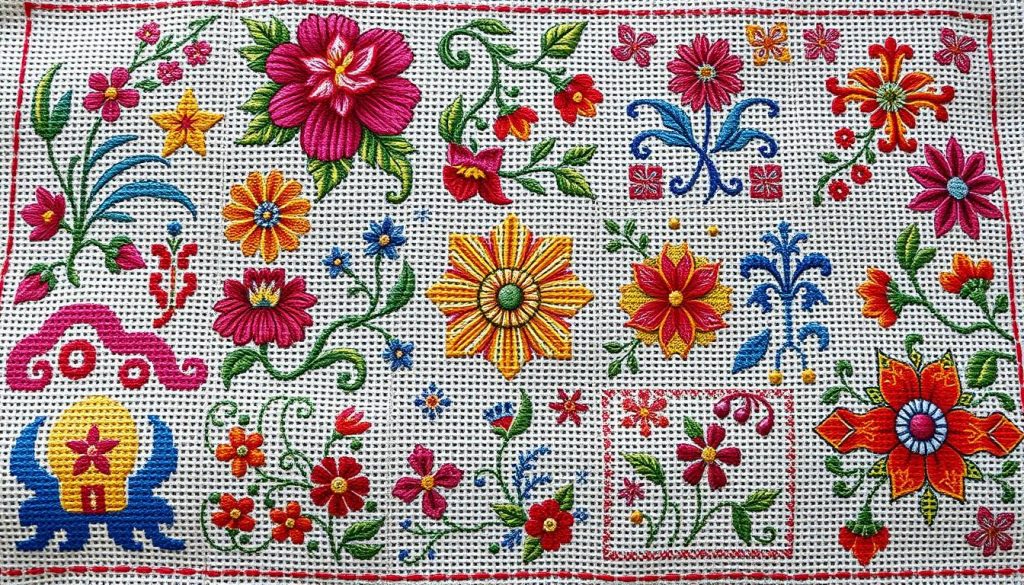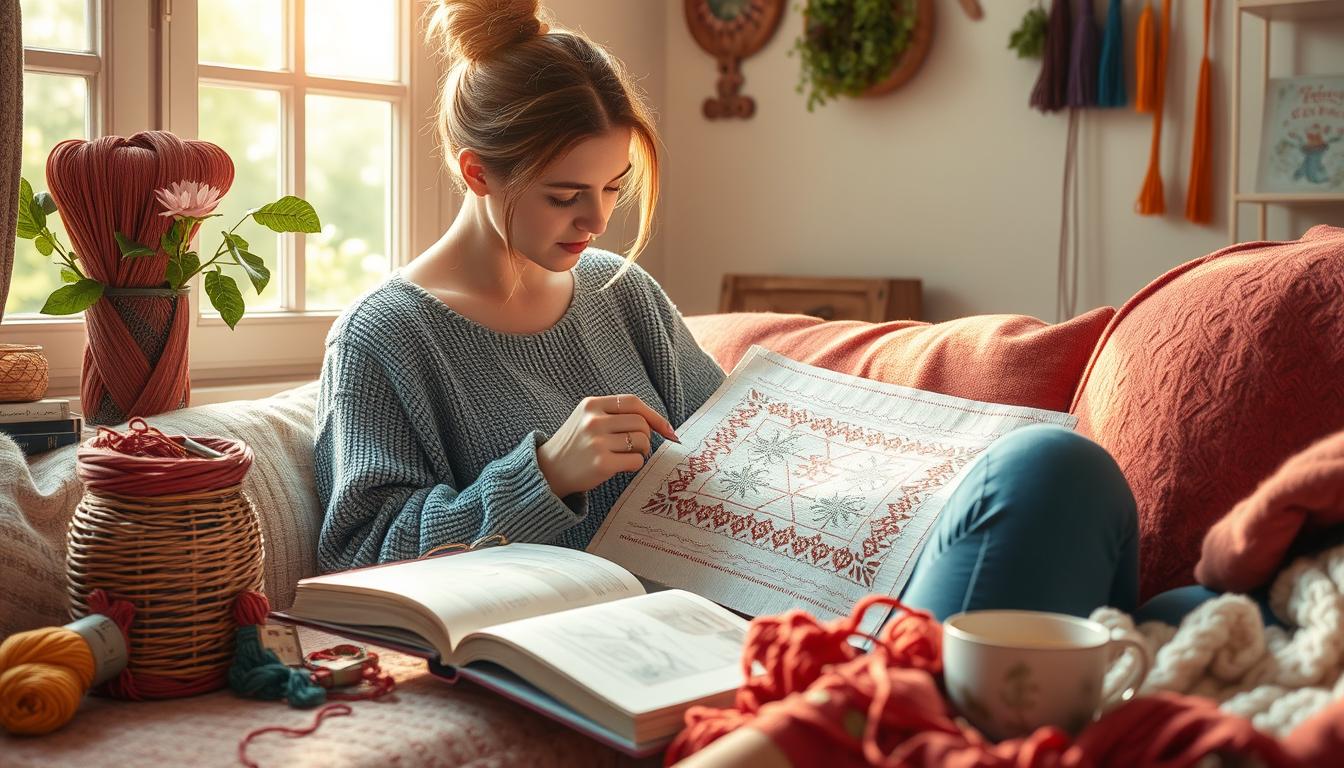Cross stitch is more than just a hobby; it’s a brain booster and stress reliever. It requires focus and attention, which can improve your thinking skills. The motion of stitching can calm your mind, like meditation, and lower stress.
It also helps with memory by keeping your brain active. This is because you have to follow complex patterns and instructions.
But crossstitching does more than just help your brain. It’s a craft that lifts your mood and can fight anxiety and depression. It also improves your hand-eye coordination and fine motor skills. Plus, it makes you more mindful and present.
Key Takeaways
- Engaging in crossstitching can improve cognitive function by sharpening attention, concentration, and hand-eye coordination.
- The repetitive and rhythmic motion of cross stitching can induce a relaxation state similar to meditation, reducing stress levels.
- Cross stitch involves following patterns and instructions, aiding in memory improvement through mental stimulation.
- Cross stitch contributes to the development of fine motor skills, dexterity, and hand strength.
- Involvement in crossstitching can uplift spirits and potentially help combat anxiety or depression by boosting mood and increasing dopamine levels.
Understanding Cross Stitch
Crossstitching is a fun and detailed embroidery art. It involves making X-shaped stitches on fabric to create beautiful patterns. This art, known as counted cross stitch, is great for both simple and complex designs. It’s perfect for beginners and experts alike.
What is Cross Stitch?
Cross stitch uses a needle and thread to make X-shaped stitches on fabric. The fabric used is usually 14 count Aida cloth, which helps keep stitches even. Most crossstitching is done with two strands of embroidery floss, which gives a nice texture.
The pattern will tell you how many strands to use. This helps even beginners do their first projects.

A Brief History of Cross Stitch
Cross stitch has been around for centuries. It started in the Middle Ages and came from China’s decorative patterns around 600 AD. These designs traveled to Europe, making crossstitching popular there.
Today, crossstitching is a favorite hobby. It’s both calming and creative. About 70% of cross stitch purchases are kits, making it easy for new crafters to start.
“Cross stitch is accessible to everyone; even children can learn it with ease, making it a wonderful and educational pastime.”
Cognitive Benefits of Cross Stitch
Crossstitching is more than just an art form. It’s a powerful tool that boosts brain health and cognitive skills. It offers mental benefits like improved focus, concentration, and memory retention.
Enhancing Focus and Concentration
The intricate nature of cross-stitching requires a lot of concentration. It’s an excellent activity for enhancing focus. By following patterns and counting stitches, you engage your brain. This improves your attention span and cognitive abilities.
- Boosts concentration skills
- Enhances critical thinking and problem-solving capabilities
- Provides a form of concentration training benefiting other tasks
Boosting Memory Retention
Cross stitch also supports brain health by promoting memory enhancement. The repetitive motions and detailed patterns help re-establish neural pathways. This is especially beneficial for cognitive rehabilitation among stroke victims and individuals with brain injuries.
- Aids in memory retention
- Re-establishes neural pathways
- Promotes brain plasticity through fine motor movements
Engaging in cross-stitching offers substantial cognitive benefits. It boosts concentration and enhances memory. It’s a valuable activity in brain health crafts, offering both creativity and mental stimulation.
Cross Stitch and Mental Health
Cross stitch is more than just a hobby; it’s a powerful tool for mental health. It offers many benefits that help with emotional and psychological well-being.
Reducing Anxiety and Stress
Cross stitching is a great way to reduce stress. The repetitive motions in this art form distract you from worries. This can help lower anxiety levels.
Research from Johns Hopkins Medicine shows that cross-stitching can reduce negative thoughts and depression. It also improves mental health overall.
A study in the British Journal of Occupational Therapy found that 81% felt calm and happy after knitting. This shows that cross-stitching is a good way to manage stress and anxiety.
Fostering Mindfulness
Mindfulness through crossstitching can greatly improve mental health. The focus needed for cross-stitching keeps you in the present moment. This supports mindfulness.
The Alzheimer’s Association says that activities like cross-stitching can slow down brain aging and prevent dementia.
Studies show that creative activities like cross-stitching boost mood and self-confidence. The Journal of Positive Psychology found that people felt better and more confident after doing artistic hobbies. The American Journal of Public Health also notes that group activities like cross-stitching improve mental health and social inclusion.
Cross stitch encourages creativity and personal growth. You can choose patterns and colors that reflect your taste. This not only reduces stress but also helps in self-expression and skill development.

| Study | Participants | Findings |
|---|---|---|
| British Journal of Occupational Therapy | Knitting Activities | 81% reported calm and happiness |
| Johns Hopkins Medicine | Creative Activities | Reduced negative thinking, decreased depression symptoms |
| Journal of Positive Psychology | Creative Hobby Participants | Boost in mood and self-belief |
Developing Fine Motor Skills
Cross stitching is great for improving fine motor skills at any age. It involves actions like threading a needle and making small stitches. These actions boost hand-eye coordination.
Children as young as 6 can start with simple patterns. They can use larger grids like binca. Regular practice helps them get better at crossstitching, improving their coordination and dexterity.

Hand-Eye Coordination Improvement
One big plus of cross stitching is better hand-eye coordination. Kids who start early can improve their motor skills. They learn patience and concentration, which boosts their creativity.
They can pick colors and make unique designs. This helps their self-esteem and mental health.
Benefits for Aging Adults
For older adults, crossstitching is also beneficial. It keeps hands and minds sharp, which is key for staying independent. Cross stitching is calming and reduces stress.
It’s a great way for seniors to stay physically and mentally healthy. Crossstitching offers many benefits for aging adults, making it a fulfilling activity.
Social Aspects of Cross Stitch
Getting into crossstitching can really boost your social life. It helps you feel part of a community and find a sense of belonging. This part talks about how cross stitch groups and workshops bring people together. They offer emotional support and chances to meet new friends.
Building Community Through Crafting
Crossstitching groups are great for meeting others who love the craft. You can join local clubs or online forums. These places are filled with people who share your passion. Working together on projects in workshops can also help you make friends.
These connections are key in fighting loneliness and improving your mood. They make you feel less alone and more supported.
Sharing and Learning Together
One of the best things about crossstitching is learning from others. Workshops and groups often have experienced stitchers who share their knowledge. They teach new techniques and patterns.
This not only makes you better at stitching but also builds a supportive network. The social side of cross stitch is very rewarding. It offers a chance for real connections and emotional support.
| Statistics | Details |
|---|---|
| Facebook Audience | 8,003,460 |
| Female Participation | 89% |
| Age Group (25-34) | 30.75% |
| Relationship Status (in a relationship or engaged) | 57% |
| Education Level (College Degree) | Majority |
| Survey Participants | 150 from 18 countries |
Getting Started with Cross Stitch
Crossstitching is becoming popular again among crafters. It’s easy to learn, making it great for beginners. Having the right supplies is key for a fun experience.
Essential Supplies You Need
A good crossstitching kit has everything you need to start. You’ll find Aida and linen fabrics, which offer different textures. Embroidery floss, made of six strands, is a must-have.
You’ll use one or two strands at a time for the right thickness. A round-end tapestry needle is best for its ease and safety for your fabric.
When starting, thread your floss without a knot at the end. This prevents lumps. Keeping your stitches tight is important for a smooth finish. Letting your needle and thread hang helps to avoid twisted floss.
Beginner-Friendly Patterns to Try
There are many free cross stitch patterns for beginners. These patterns come with step-by-step tutorials. Alphabet samplers, small flowers, and shapes are great for beginners.
For more learning, try a ‘How to Cross Stitch Course for Beginners.’ It offers a structured way to learn. Start with simple projects and move to harder ones as you get better. Enjoy this timeless craft and watch your skills grow.
